
Alberta Landscapes Part I
by Dr. Robert Berdan
September 1, 2019
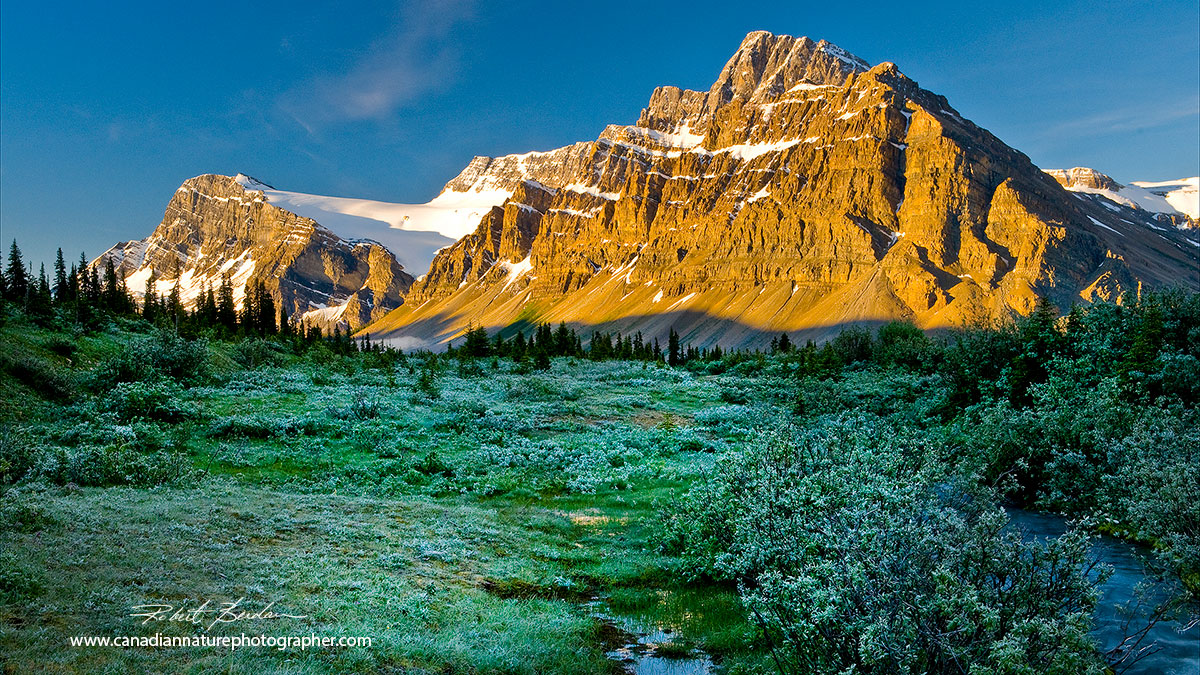
Crowfoot mountain and vulture peak to the left photographed a few feet away from the highway in Banff National Park shortly after sunrise. I like the contrast between the cool colours in the foreground and the warmer light of the sun on the mountain.
I have been photographing Alberta landscapes and wildlife for over 30 years and I thought I would share some of my favourite places and photos of Alberta. Like most photographers I tend to get my best photos near where I live because I can visit a location over and over again in different light, seasons and time of day. Landscape photography can be relaxing because usually you need to quite your mind and compose carefully and be in the moment. If you are interested in capturing your own images I hope these images might inspire you to check some of these locations if you plan to visit Alberta. If you are interested in buying my images please contact me.

Moraine lake and the ten peaks is a popular destination in Banff National Park. Anyone can take a good photo here, the trick is finding something different. Sometimes I will explore and make panoramas, or shoot in black and white or try some other technique.
Alberta is unique in that it offers badlands, prairies, foothills and Rocky Mountains. It is also a mecca for wildlife photographers. Most photographers head to the mountains and for good reason the scenery is spectacular. However, if you are coming for a longer stay consider visiting some of the badlands. The prairies can also be beautiful in late summer with the bright yellow canola fields.
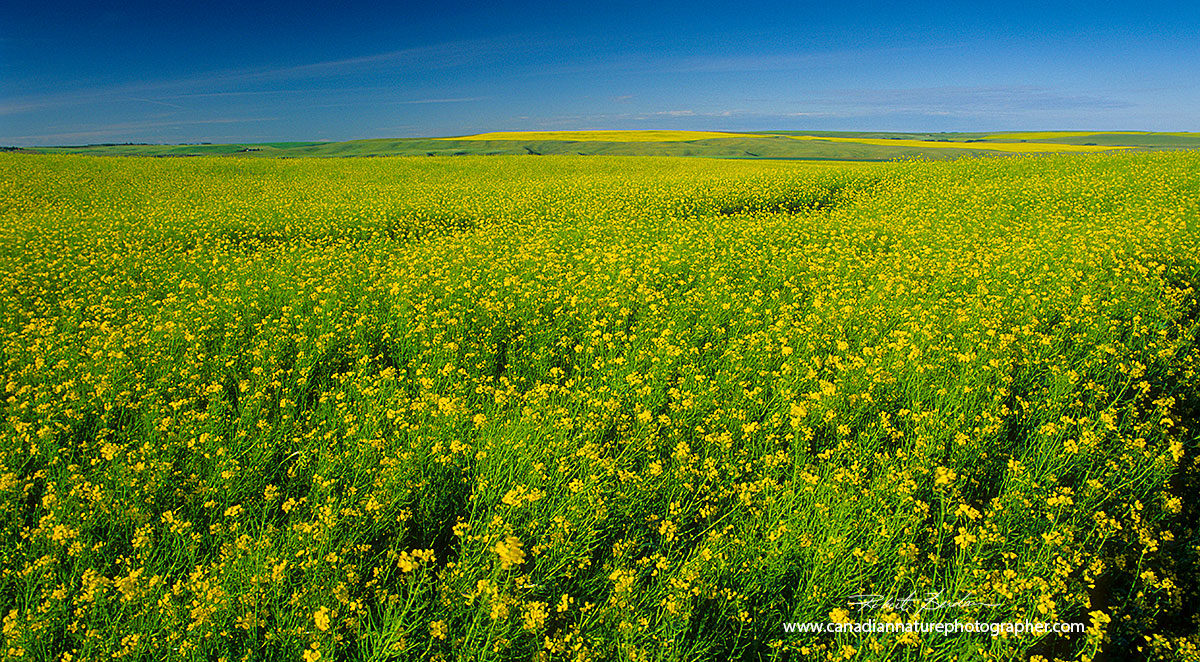
Canola field east of Calgary, Alberta
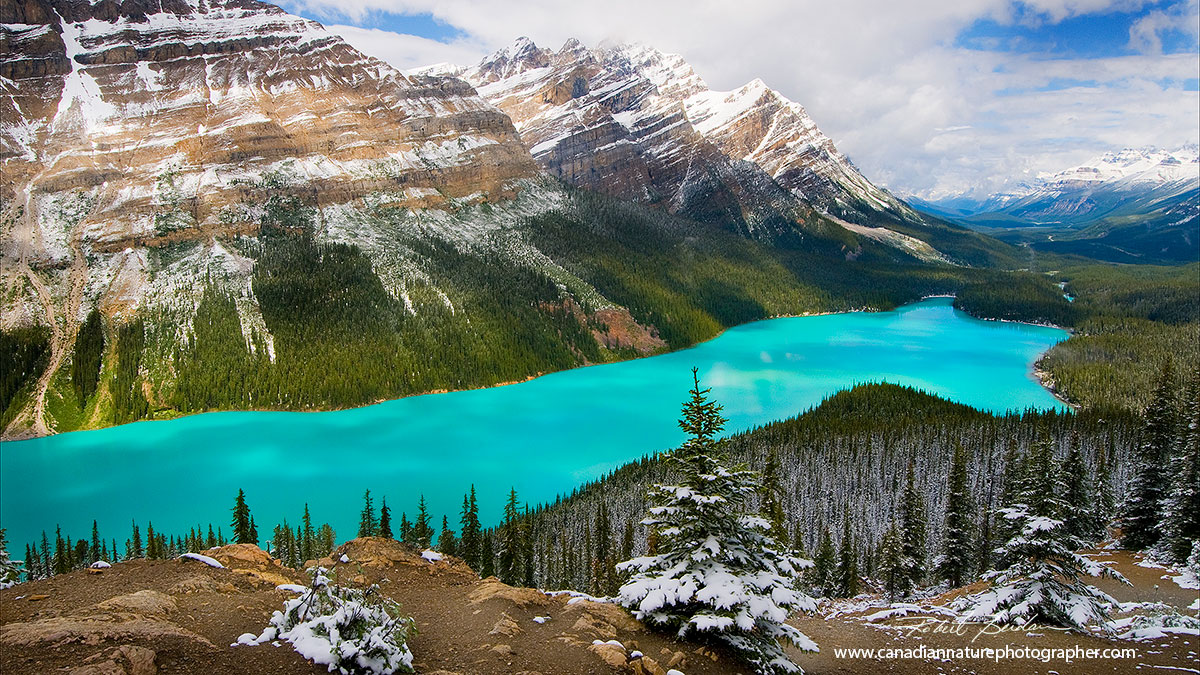
Peyto Lake in Jasper National Park is next to the highway and a popular spot to photograph this aqua-blue lake. The fresh snowfall occurred in July!
Landscape photographs are easier to take than wildlife in that you usually don't have to hurry if you arrive early. I consider a tripod to be essential for good landscape photography. The tripod not only steadies your camera, but it allows you to compose more carefully and achieve a greater depth of field by using F-stops F-11 to F32. I sometimes use neutral density grad filters, a polarizing filter or I take several exposures and blend them together (HDR high dynamic range). For an even greater depth of field I sometimes use focus-stacking in some of my landscapes. This technique involves combining two or more photos taken at different focus points. My two favourite lenses for landscape photography are my Nikon 20-35 mm and my 70-200 mm lens. The telephoto lens tends to flatten the perspective.

In this winter scene taken just north of Calgary the telephoto lens flattened the perspective. Nikon 70-200 mm lens.
The quality of the light is the most important element for me in making an effective landscape image. Using a tripod lets me shoot in low light or at night and I can use long time exposures. Understanding visual elements of design and composition will help you make better pictures and I have put all I know about this topic in another article on this site.
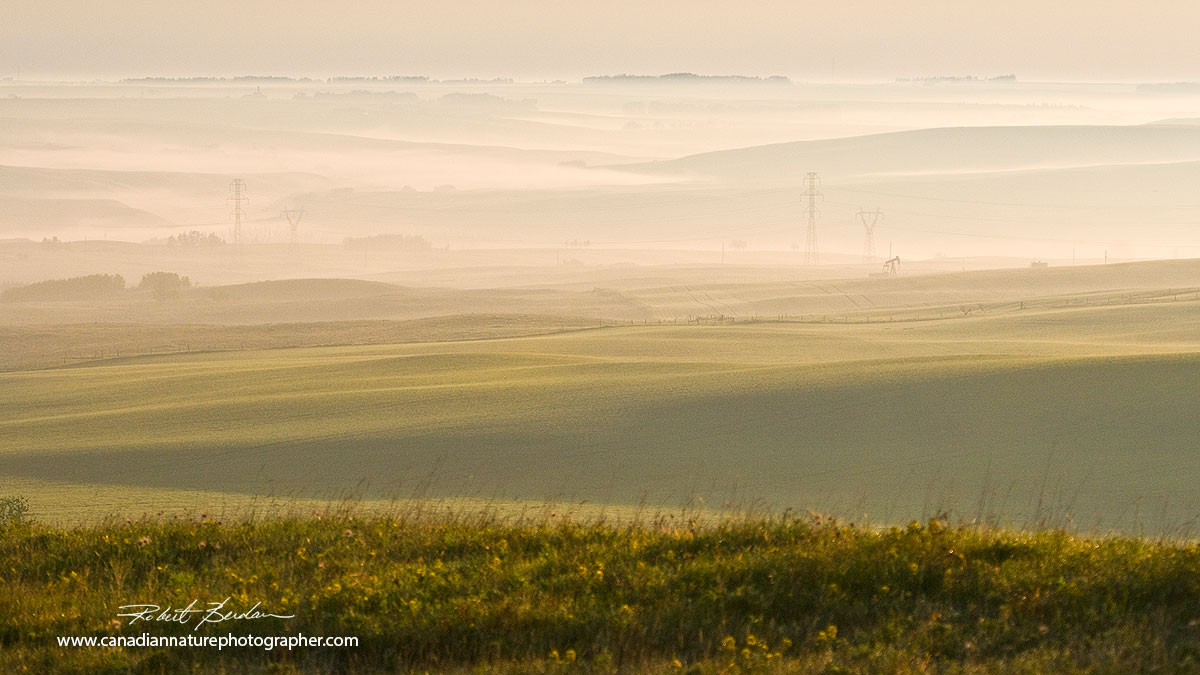
Early morning photo taken on bears paw road north of Calgary. Fog is still hanging in the valleys and the landscape is lit from the side by the recent sunrise.
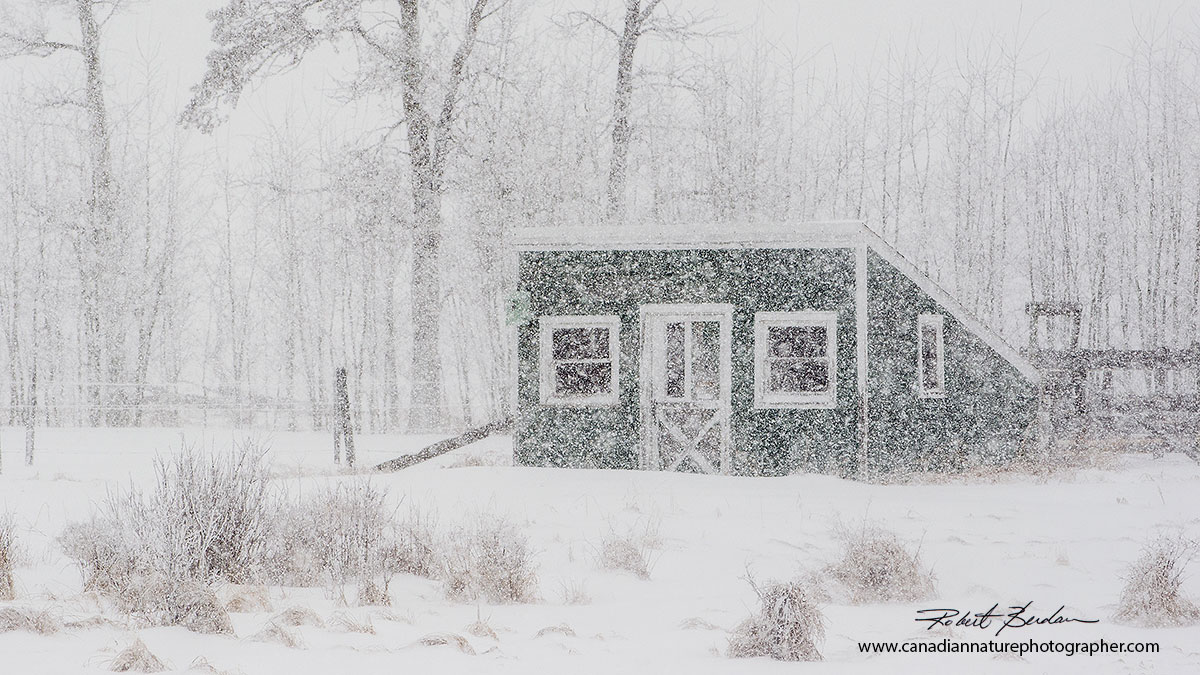
Whereas some photographers put their cameras away in winter, I have come to appreciate the uniqueness of winter scenes. I lived in Houston for four years while attending grad school and it made me more sensitive to changes to the seasons in Canada. I now embrace winter photography though it is important to be prepared and dress accordingly.
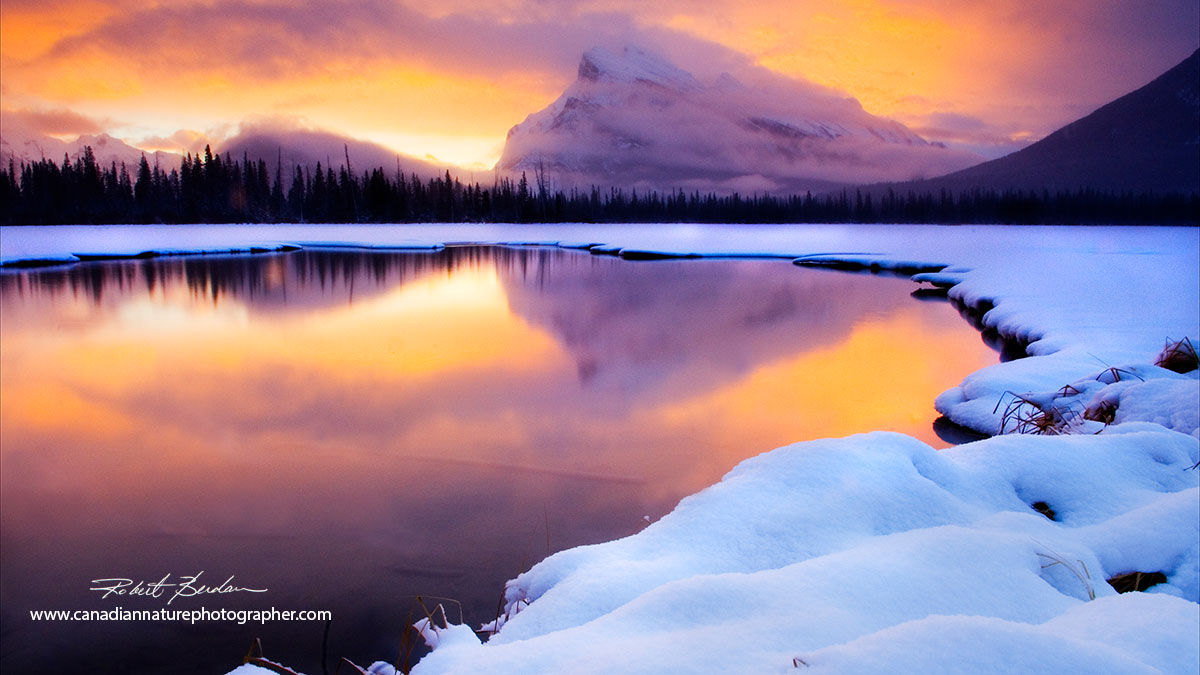
Sunrise at Vermilion lakes just outside the town of Banff. I have been to this location hundreds of time, but on this occasion I had a group of photographers I brought and the light was amazing.

Mount Rundle and Two Jack Lake in the early evening in Banff National Park

Sunrise Vermilion lake with Mt. Rundle outside of the Banff Town site.
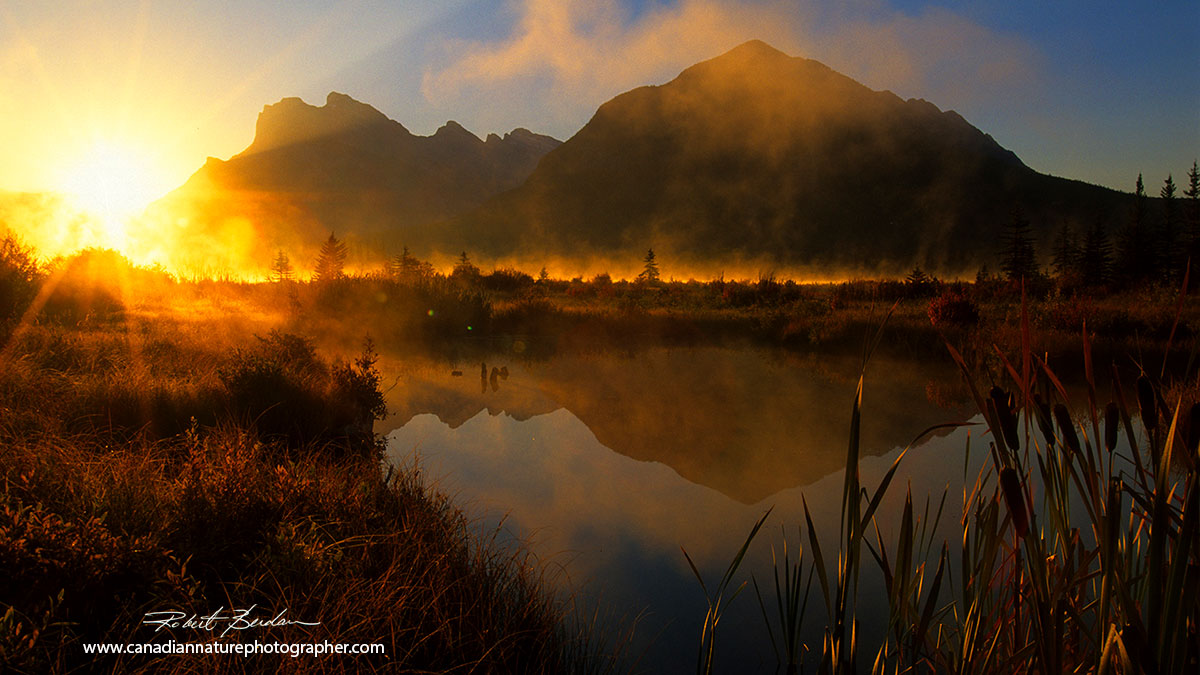
Sunrise Vermilion lake Banff National Park
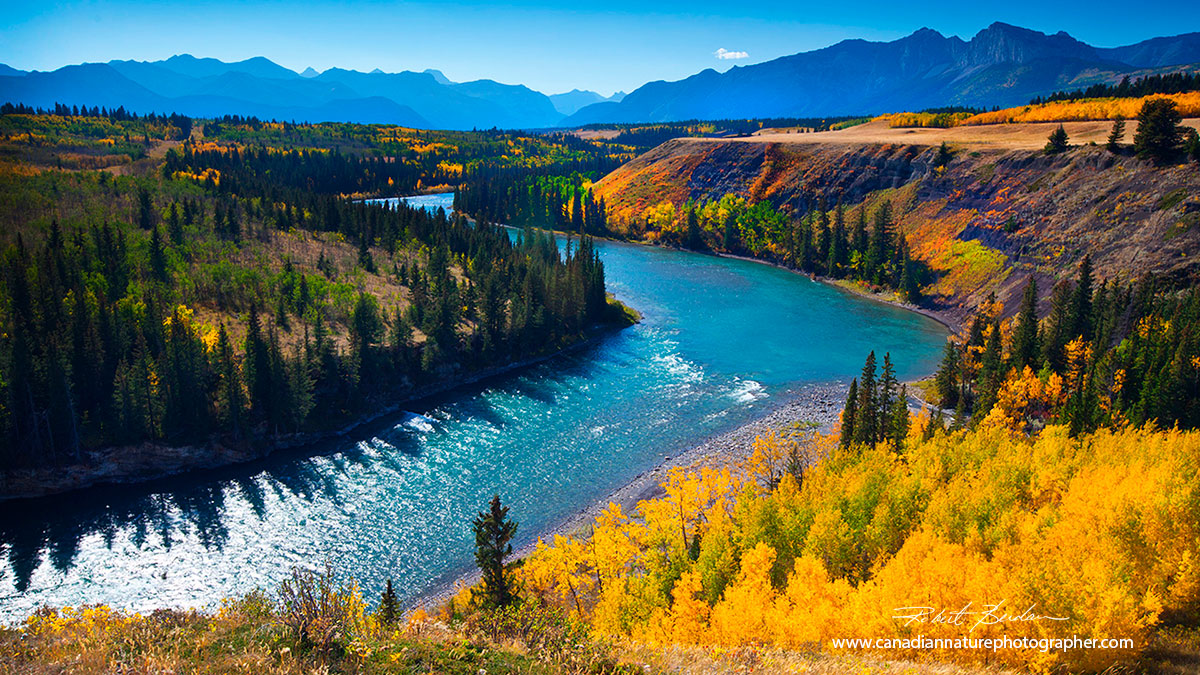
Above - the Bow river valley in autumn from Stoney Plain Park. The gate to this park is operated by the Stoney tribe and is not always open. The road is rough in places but I drive a jeep. This location was used in the movie by Paul Gross - The Battle of Vimy Ridge. Paul had a cabin overlooking the river valley which I recognized immediately.

Rocky Mountain foothills at sunrise in autumn. There are many locations where you can get this type of scene in the early morning - just head north of Cochrane on Highway 22.
Lake Louise
Lake Louise maybe the most popular destination in Banff National Park and it has a lot to offer from a photographers view point. In winter they have a festival with ice carvings and sporting events. It's popularity is also its down fall since you will almost always encounter crowds. That said - I would try to arrive very early. The hotel has many shops and it's beautiful inside. There are also hikes around the lake and up the mountain to the tea house which offers a spectacular overview of the lake from above.
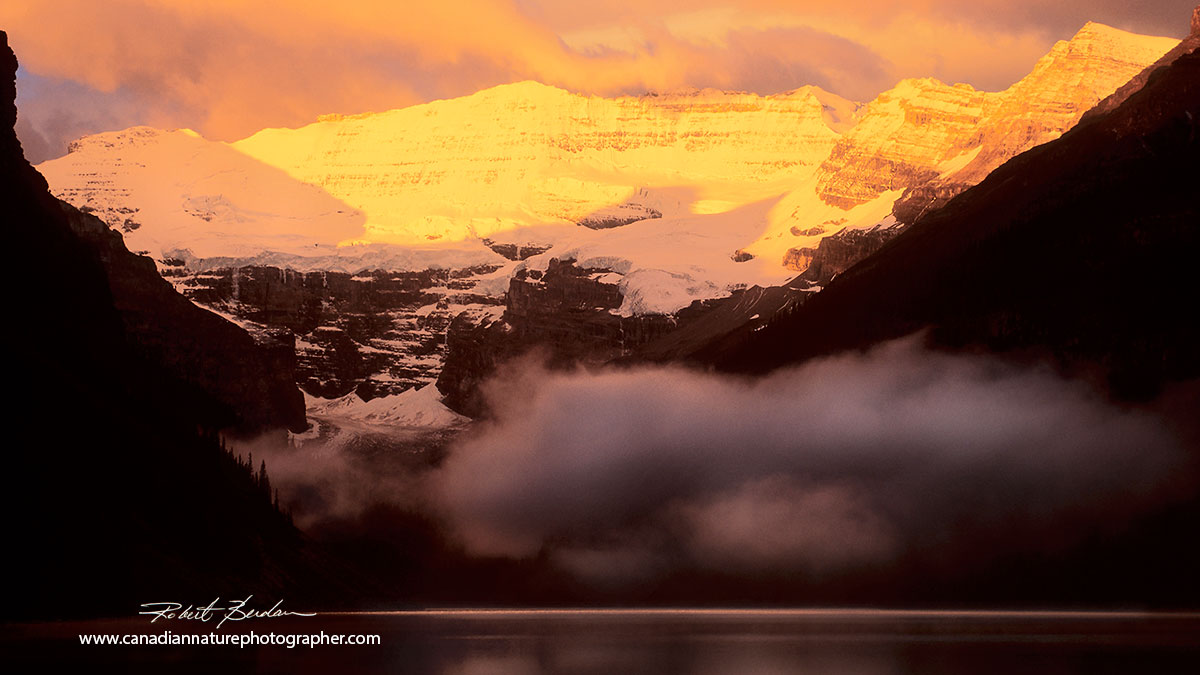
Lake Louise in summer about 5 am - first light is hitting the glacier. Before I took this photo it was foggy and raining. A friend (Don Baker) that came along with me decided to stay in the car and sleep - he missed this rare photo opportunity.

This is what the lake Louise boat house looked like about a half hour before the photo above was taken. It was foggy, but I liked the mood the fog created.

Above is a photo of lake Louise in January mid day. There was a winter festival being held in a few days later and I was checking if this would be a good place to take a group of photographers interested in winter-photography.

During the winter festival I snapped this shot of some hockey players and it captures what I consider to be a very Canadian photo - hockey in the Rockies.
I don't go to Lake Louise very often anymore because it has become so crowded that on weekends or when ever it is busy you may have to take a bus up to the Hotel and lake. Even early in the morning in can be quite crowded. Of course if you are travelling from far away it is still worth the trip, but I find that I try to seek out locations with fewer people to take photographs nowdays. I don't really enjoy photographing nature or landscapes when I am in a crowd. There are many locations that offer good photo opportunities in the parks that are not crowded. More photographers are now starting to include the night sky in their photographs to avoid crowds and capture something different.
Moraine Lake

Canoes for rent on the boat docks at Moraine Lake.
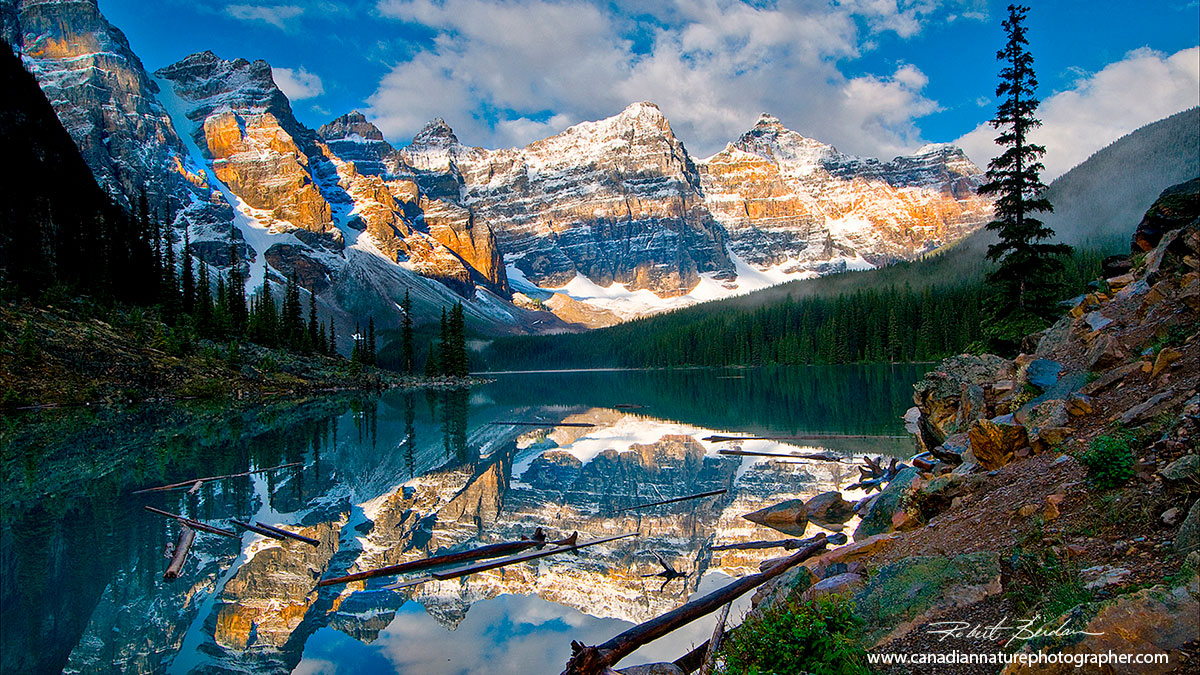
Above is Moraine lake. This view is spectacular though they have now put fences and rails to block you from some vantage points. The best time for photographs is early morning because the light will come from behind you, and if you arrive after 10 am you may not get a parking spot and have to walk a long way from your car. The lake is only accessible to cars while the road is open May 22 to October 10. There are some beautiful hikes around this area. If you hike the area I recommend bear spray, make noise on the trail and if possible hike in a group. Some folks walk from Lake Louise or cross country ski the 14 km distance when the road is closed.
Kananaskis
Kananaskis also called K country is one of my favourite parks in Alberta. It is about an hour drive from Calgary. It is a provincial park so there are no fees to enter the park and it's less known that the National Parks. There are fewer people visiting the park, and wildlife is more abundant especially moose and grizzly bears. There are some restaurants and a ski-resort in K country. There are many hiking trails, but even a short trip with the car will offer you some spectacular scenery. If you would like to learn more see my recent article on Kananaskis and others on this site. This park seems to be popular with the movie industry so in the off season you might see some movie crews or movie stars.
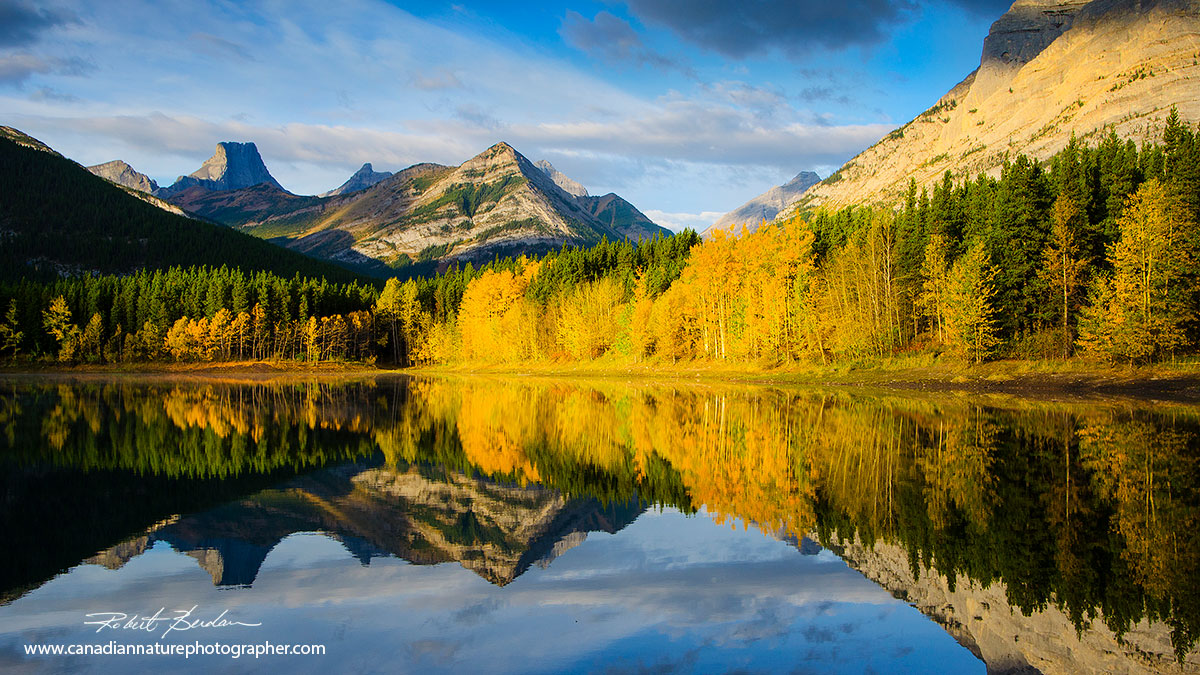
Wedge pond is a favourite spot of mine to photograph the autumn colours reflected in the lake in late September.

Upper lakes Kananaskis offers many trails and spectacular scenery from the parking lot.

Spillway lakes is on the Spray lakes road. The shallow water is often calm forming a mirror reflecting the surrounding mountains.

Upper lakes Kananaskis with Mt. Sarrail in the background. If you watch the X-men movie this mountain appears in the background where the Wolverine (Hugh Jackman) enters a secret facility.

Cone Mountain in the Spray lakes area in Autumn.
I visit Kananaskis in all seasons throughout the year to photograph landscapes, wildlife and more recently to collect pond samples to photograph with my microscope.
Foothills and Southwest Alberta

Foothills from a country road near Black Diamond, Alberta.
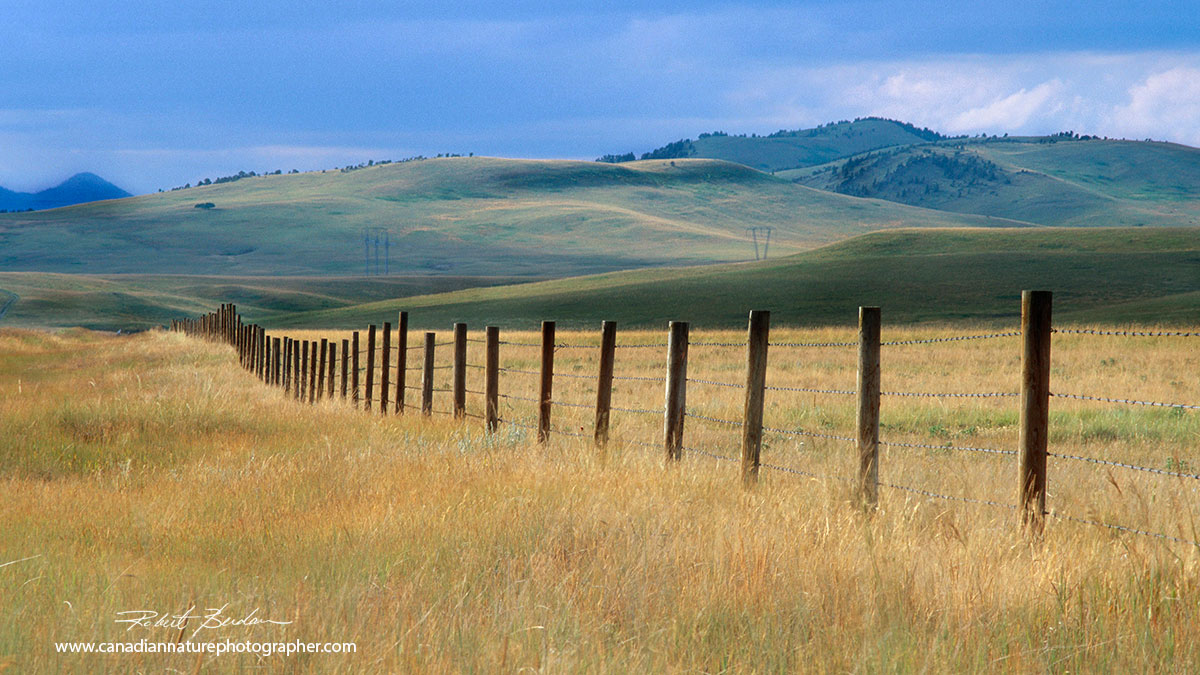
Foothills and the Whale back region in southern Alberta next to highway 22.
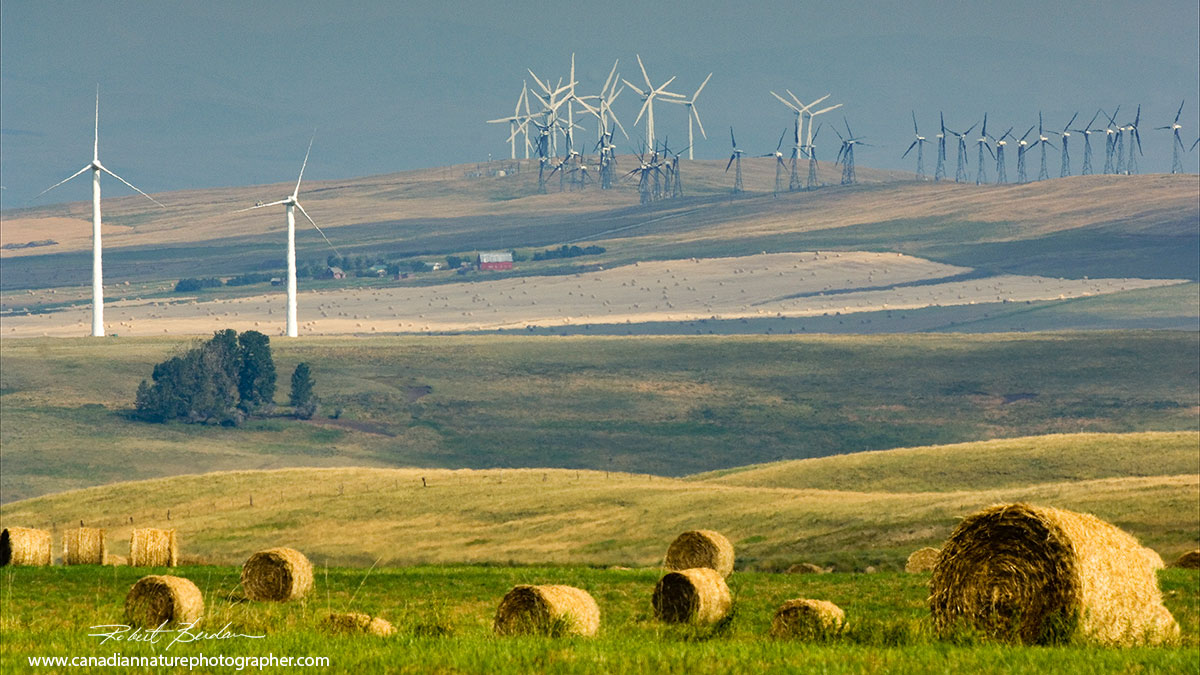
In the Pincher creek area of South west Alberta there are a growing number of wind generators because of the high winds experienced in the area.

Above a field south of Pincher Creek en route to Waterton National Park. The early morning light and storm in the background created the beautiful contrast.
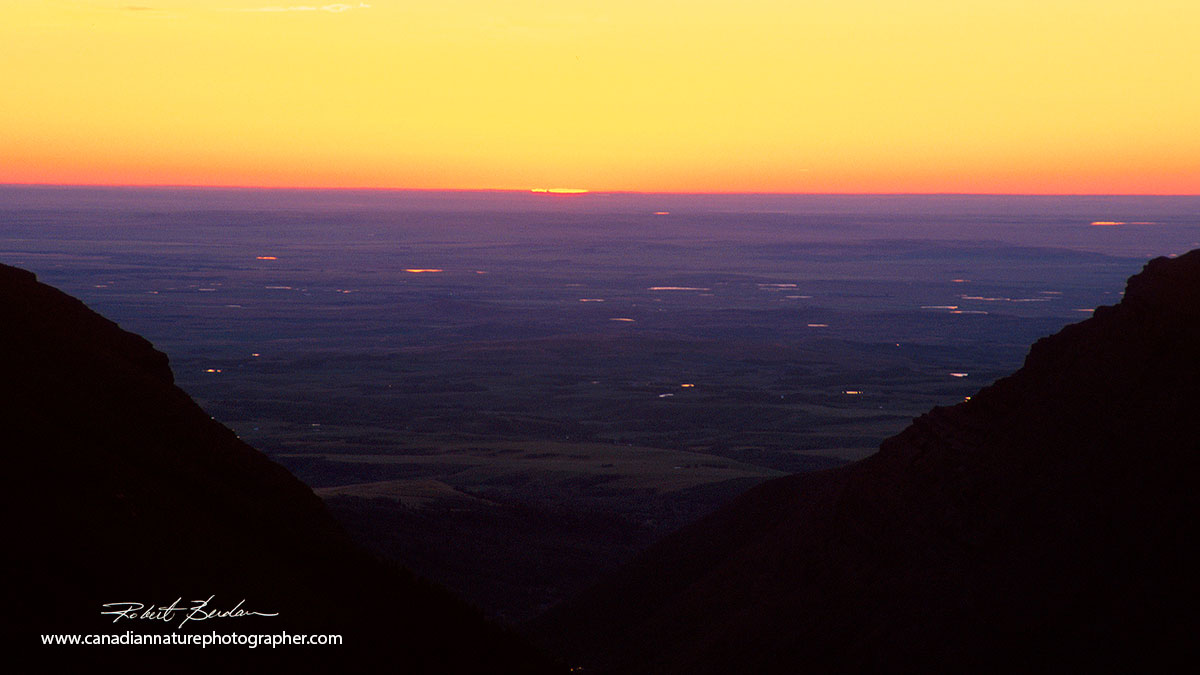
View from the top of a mountain in the Castle Wilderness. The sun was just coming up and I had hiked with a group from CPAWS that are involved in protecting this area. We started hiking to the top of the mountain from our base camp at 4 am in order to be in position as the sun came up. Hiking in the dark was a new experience for me especially in bear country, but we had a group of about 20 including a videographer. When I got to the top my assignmnet was to photograph a family at sunrise (see below) - I was shooting Velvia film at the time. I brought a 4 x 5 inch camera with me, but the wind was so strong I opted for my smaller 35 mm camera.
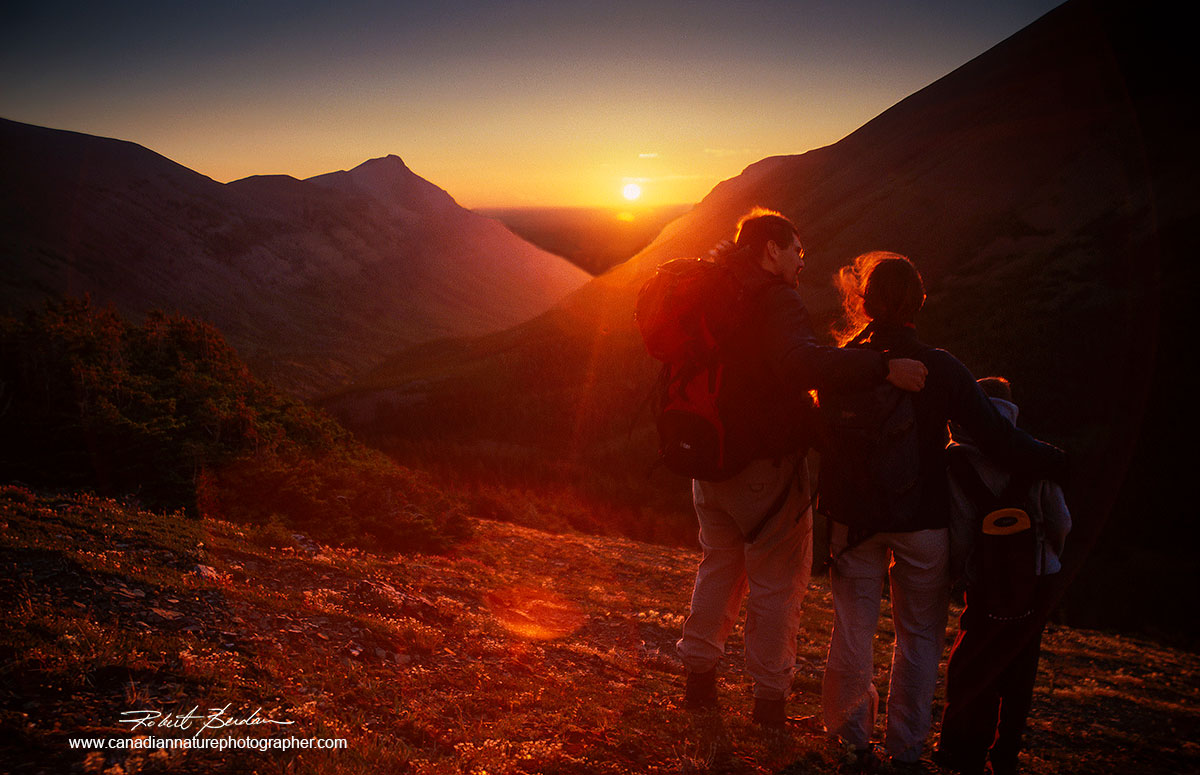
Family near the top of a mountain in the Castle Wilderness in South West Alberta at sunrise. This picture was taken over 20 years ago.
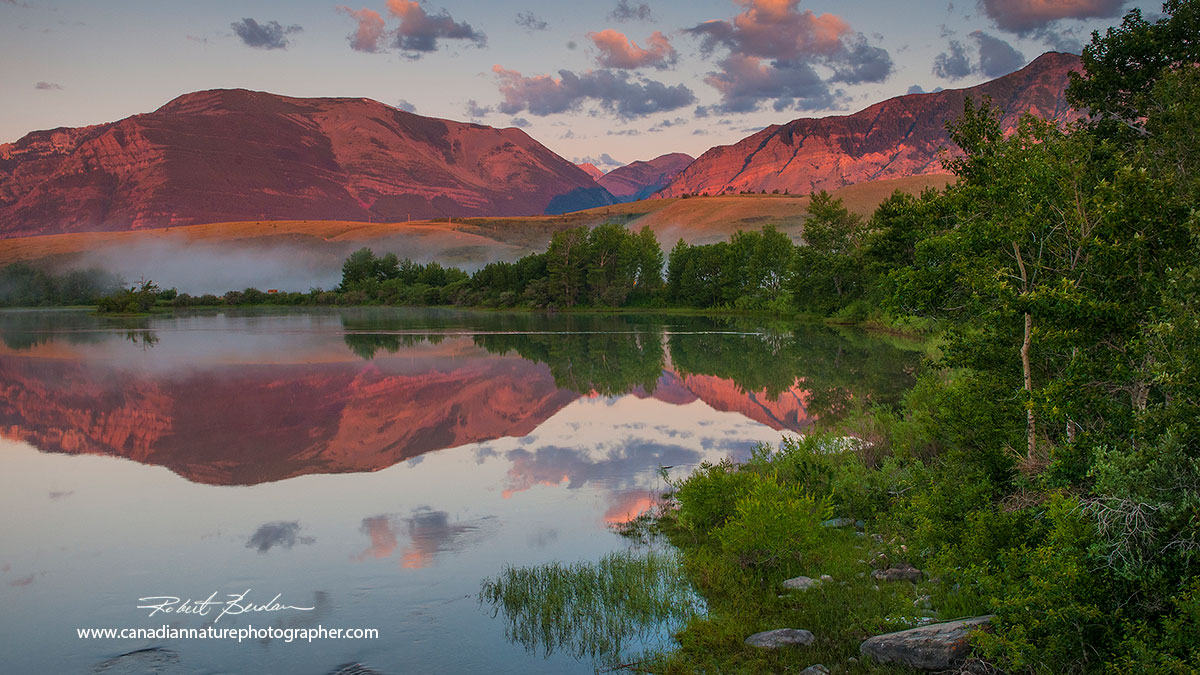
Lower Waterton lake near the entrance of the Park at sunrise

View from the Bears hump, a short steep hike in Waterton National Park, that provides an overview of the town site below.

Belly river near Waterton National Park in south west Alberta. The Belly river was painted by some members of Canada's group of seven.
Writing-on-Stone Provincial Park and Red Rock Coulée
These are two of my favourite locations to take photographs. Writing-on-stone offers a campground which gets busy in summer. There are showers in the campground and some folks swim or raft on the milk river. The main attraction is the sandstone hoodoos and petroglyphs on the walls. The landscape is magical especially early and late in the day. You may encounter rattlesnakes in the area, deer and Pronghorn antelope are also common.
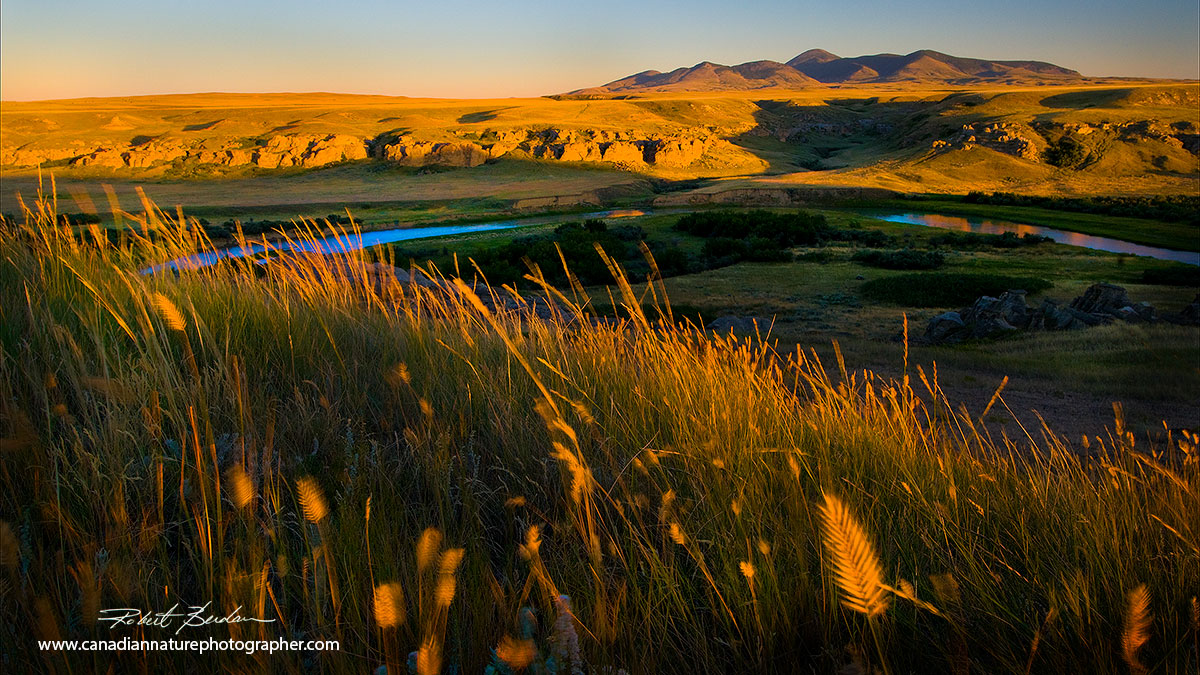
Above - view of milk river valley with the Sweet grass hills visible in Montana in the background.

Similar view of the river valley in Writing-on-Stone Provincial Park with the full moon rising.

This photos shows you some of the extensive sandstone hoodoos which you can walk on. My father has set up his camera to take pictures in the morning light.
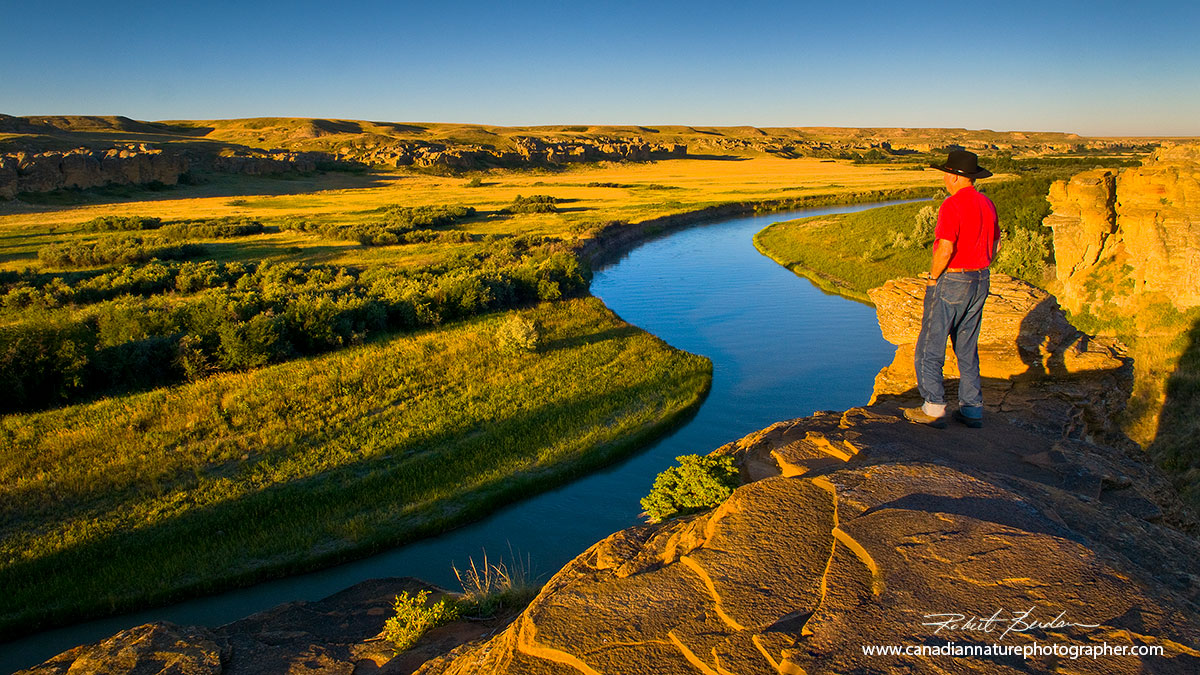
My father with his cowboy hat over looking Writing-on-Stone and the milk river.
Red Rock Coulée
Red Rock coulée is a small natural area south of Medicine Hat and another 22 km south of the town Seven Persons. I have several older articles on this site about Red Rock Coulée and several by other authors - use the Site map or Search tool on the font page to find them. One of my articles has interactive spherical VR movies of this area. I think if I had to pick one place in Alberta as my favourite it would be here. The reasons are that it is small, isolated, not well known and features these large concretions (round rocks 6-12 feet in diameter) that are believed to have formed like pearls under an ancient ocean. The rocks are high in iron content so they appear red and they are covered in orange lichen (Xanthoria). The best time to visit is early morning and late in the day. Coyotes can be heard in the evening, there are also Pronghorns, Mule deer and a variety of birds. Nighthawks can also be heard in the evening as they search for insects. Rattlesnakes are found in the area and you need to watch where you step or wear high protective boots - see the Rattle snake I photographed at Red Rock coulée in the article Alberta Wildlife on this site.
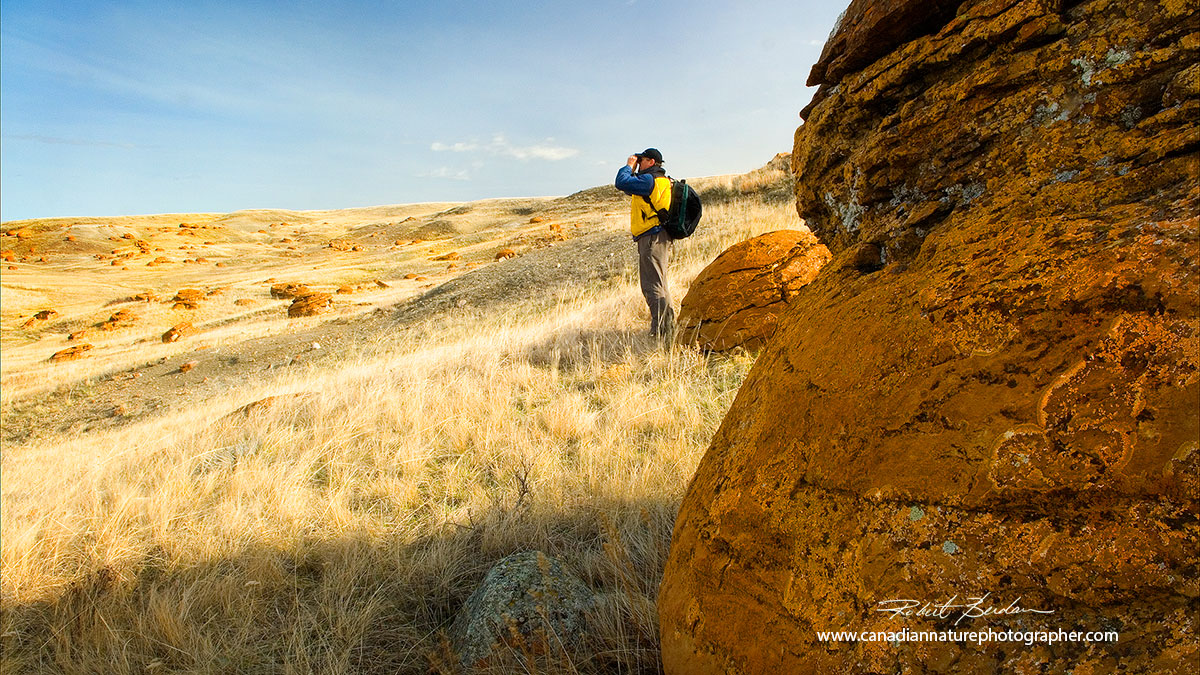
Above is a self portrait I took with my tripod and camera's self timer. I am overlooking the valley with many of the concretions.

Sunset and some of the concretions. The soil is made up of Bentonite which is a mixture of clay and volcanic ash which forms a slippery gumbo when wet. It doesn't rain here often, but if it does get out of the muddy areas immediately. There are no services here, one picnic table, a sign and a few trails. I usually sleep in my car in order to be on site at sunrise and in the late evening. I have yet to visit in winter.

Sunset showing some of the concretions that have broken up.
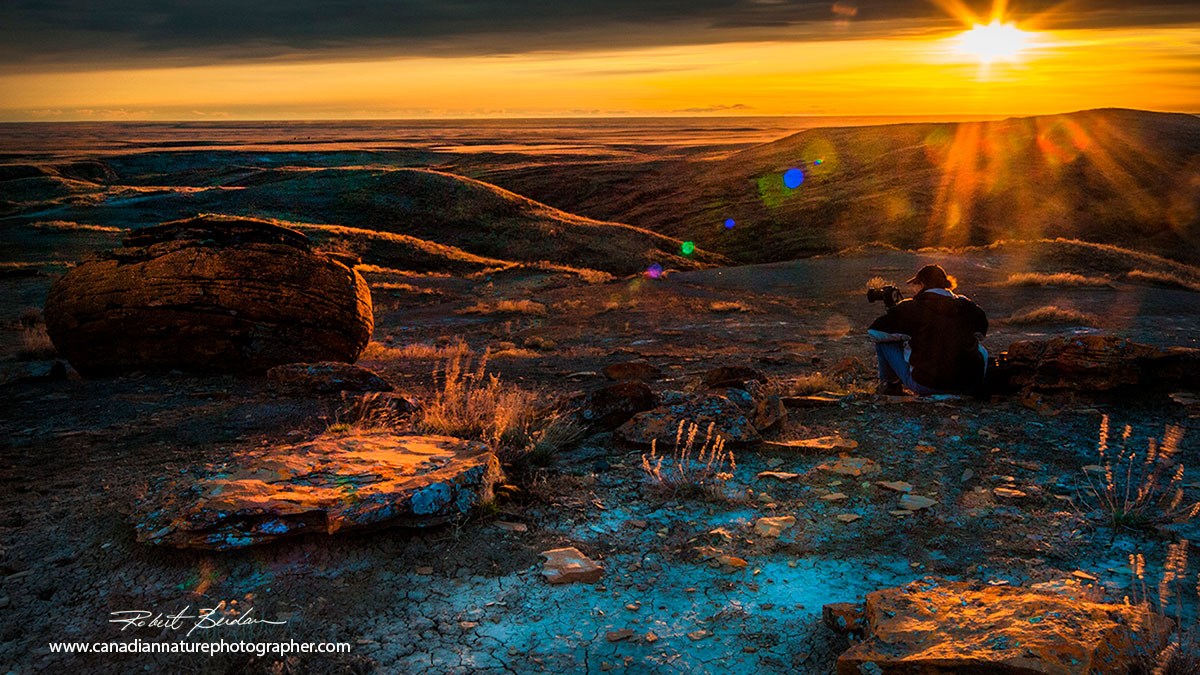
Another photographer (Gabrielle Lilly) watching the sunset at Red Rock Coulée.
Dinosaur Park & Badlands
In addition to Red Rock coulée and Writing-on-Stone there are badlands that follow the Red Deer River. Some of the best places to see these land formations is around Drumheller and Brooks Alberta. Drumheller is an excellent place to begin your visit and also host's the world famous Royal Tyrrell Museum. The museum offers dinosaur and fossil exhibits and is a must see for visitors. The area around the town site which is in the valley offers some spectacular landscapes and hoodoos. Dinosaur provincial park near Brooks Alberta offers a camp ground, tours, small restaurant and spectacular badlands scenery. It gets busy in summer, but you can visit any time of year. I personally prefer the off season when there are fewer people. In summer be sure to bring mosquito repellent. The temperature in the summer in the afternoons can reach 30°C or higher so be prepared, bring a hat and water on hikes. In this article I show some of the wildlife and in this article some spherical VR movies (requires Flash).

Sunrise over Dinosaur Provincial Park in summer.
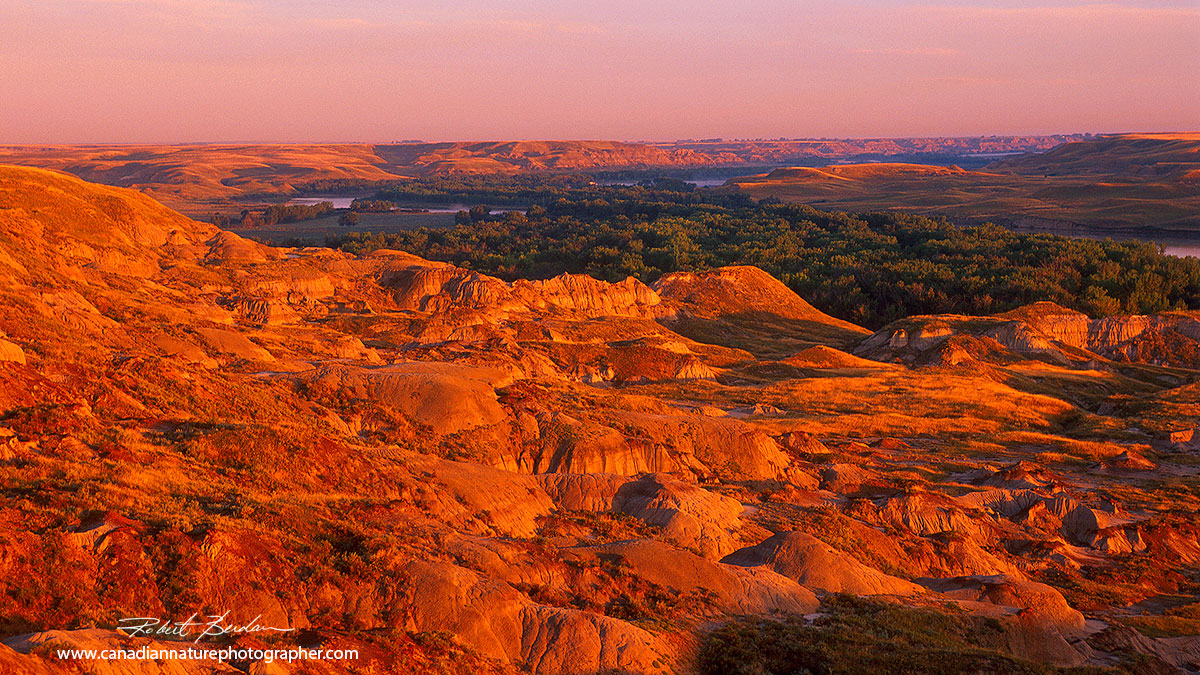
Dinosaur park overlooking the Red Deer river valley around sunrise.
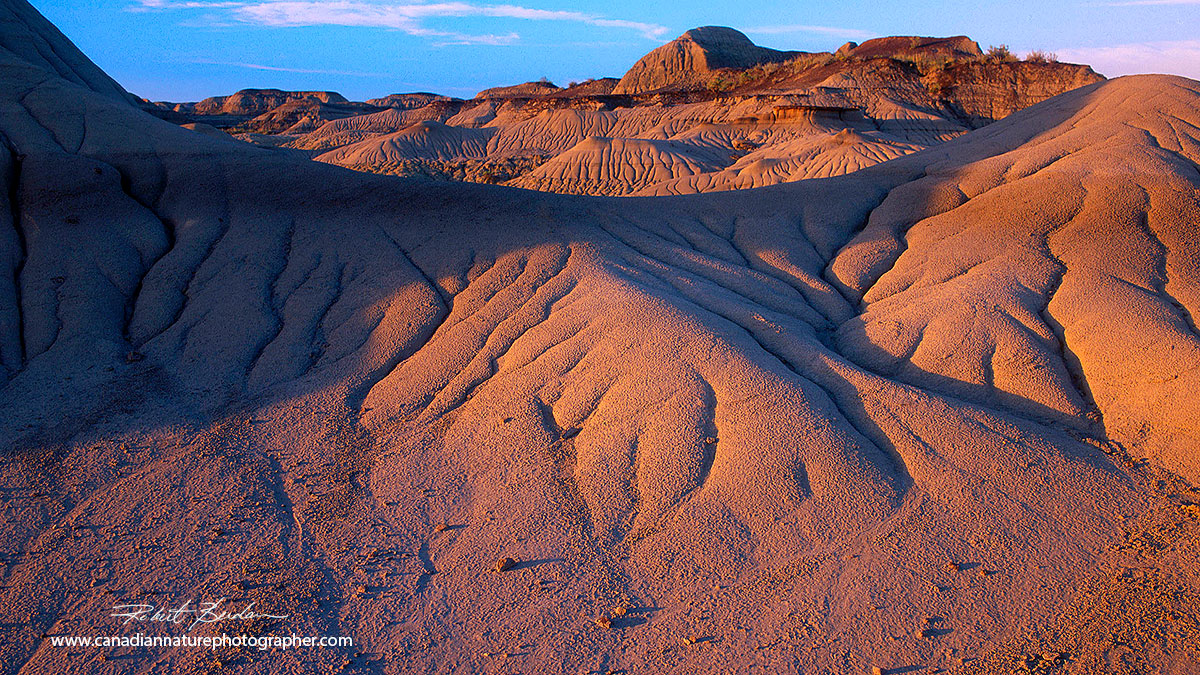
On a short hike late in the day you will see this type of terrain in Dinosaur park
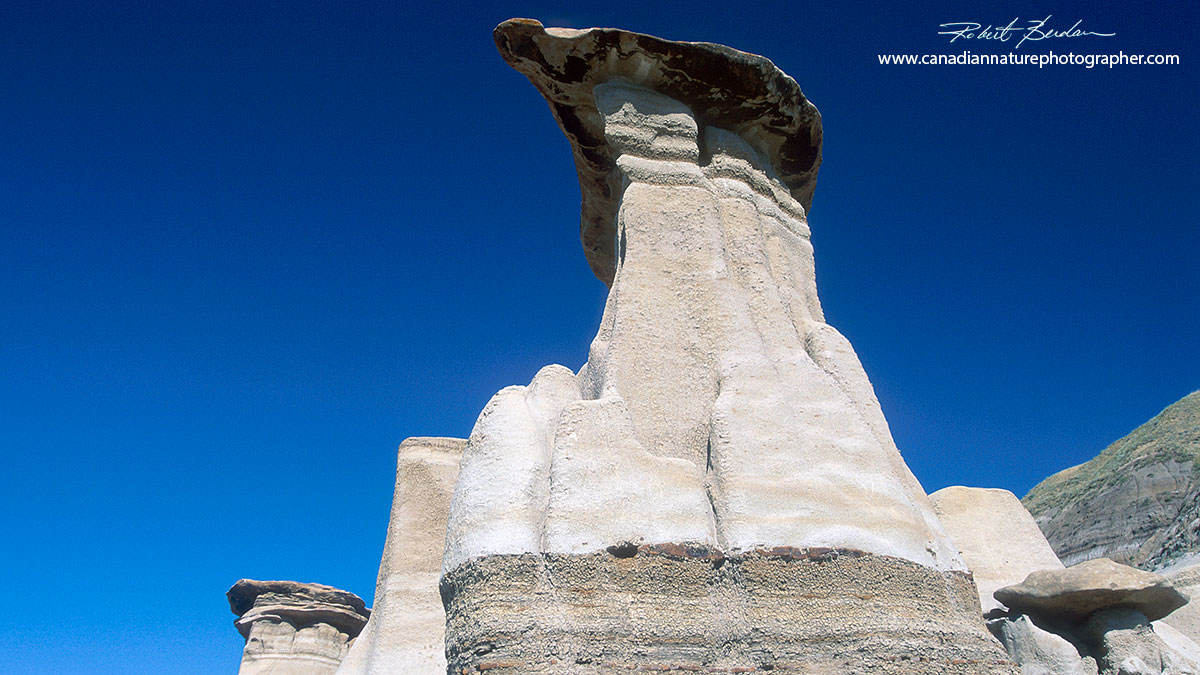
Hoodoo off highway 10 near Drumheller.
Another place to visit on your drive to Drumheller is Horseshoe Canyon. It offers some trails and a small gift shop. In summer there is helicopter that offers short rides for reasonable rates - see some of my photos here. The Nature Conservancy of Canada was donated some land in this region and has begun some restoration projects, and is developing trails in the area. I recommend visiting Horseshoe canyon in the early morning for a one or two hour hike. Bring mosquito repellent, water bottles and good hiking boots. I was hired by the Nature Conservancy to take photos of this region some of which are shown here. I think the Nature Conservancy parking lot would also make a good dark site to set up a telescope.
Jasper National Park and the Tonquin Valley
Jasper offers many beautiful vistas and opportunities to photograph landscapes and wildlife, below are just a couple of my favourite photos. One of my favourite places is the Tonquin valley. This requires a 1-2 day hike to reach or alternatively you can ride in on horse back with one of the outfitters. I have visited the valley twice to stay at the Tonquin Valley Lodge North. The lodge offers cabins, home cooked meals, canoes and in front of the lodge you can take amazing landscapes. We saw grizzly bears and mountain caribou in the valley. I hope to visit this location again.

Sunrise over Amethyst lake in front of our cabin.

I set up the tent and asked my father to hold onto the lamp in the evening - the Ramparts are on the right.
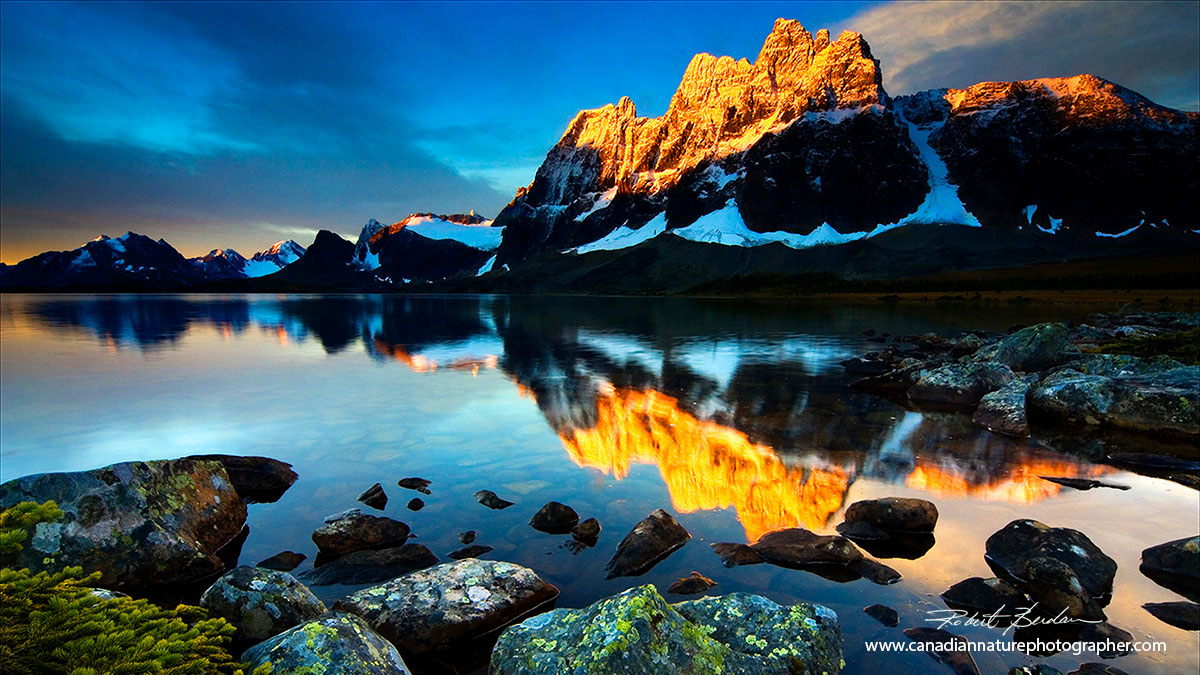
Early morning sunrise on the Ramparts and Amethyst Lake.
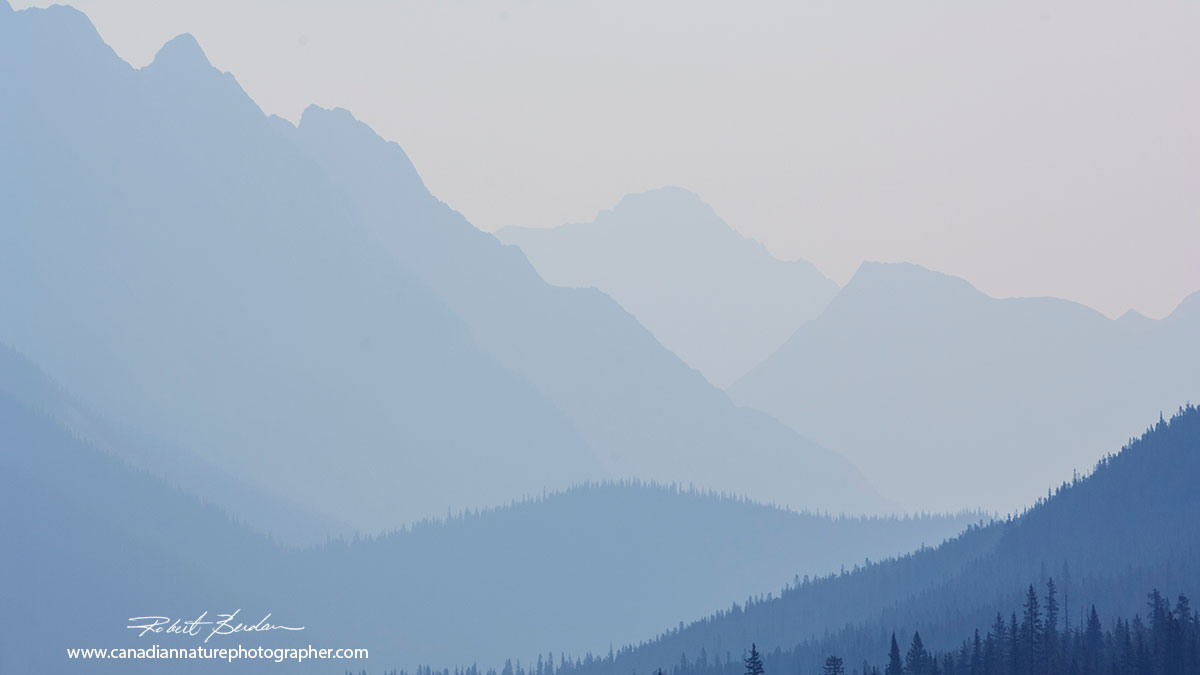
Heading down the Maligne lake road in Jasper National Park I took this photo one morning with a telephoto lens and I like the aerial perspective produced by the mountains in the distance.
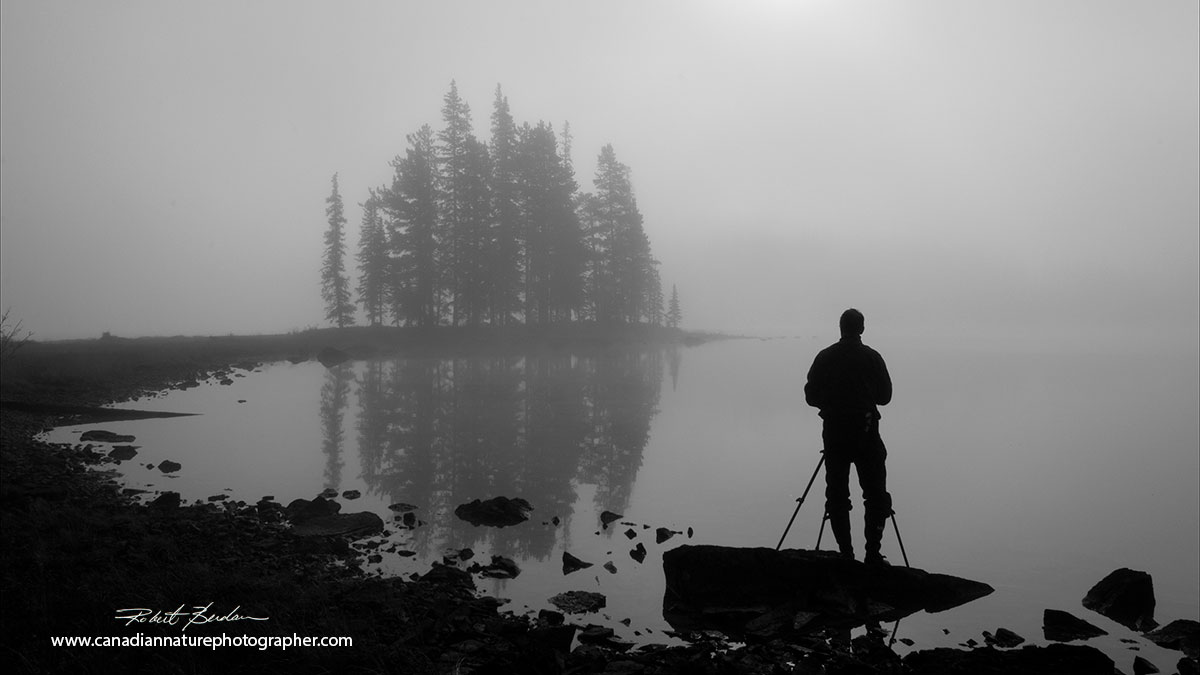
At Maligne Lake you can rent canoes or take a boat ride to Spirit Island. The boat goes down to this island between 10 am and 4 pm and gives you about 10 minutes to take photos. I arranged with friend and fellow photographer Peter Dettling to kayak down the lake and camp for a few days. This permitted us to photograph the island and lake under different lighting. The photo above was taken about 5 am before sunrise to produce this silhouette of my friend with his tripod.
Some Miscellaneous Alberta Landscapes
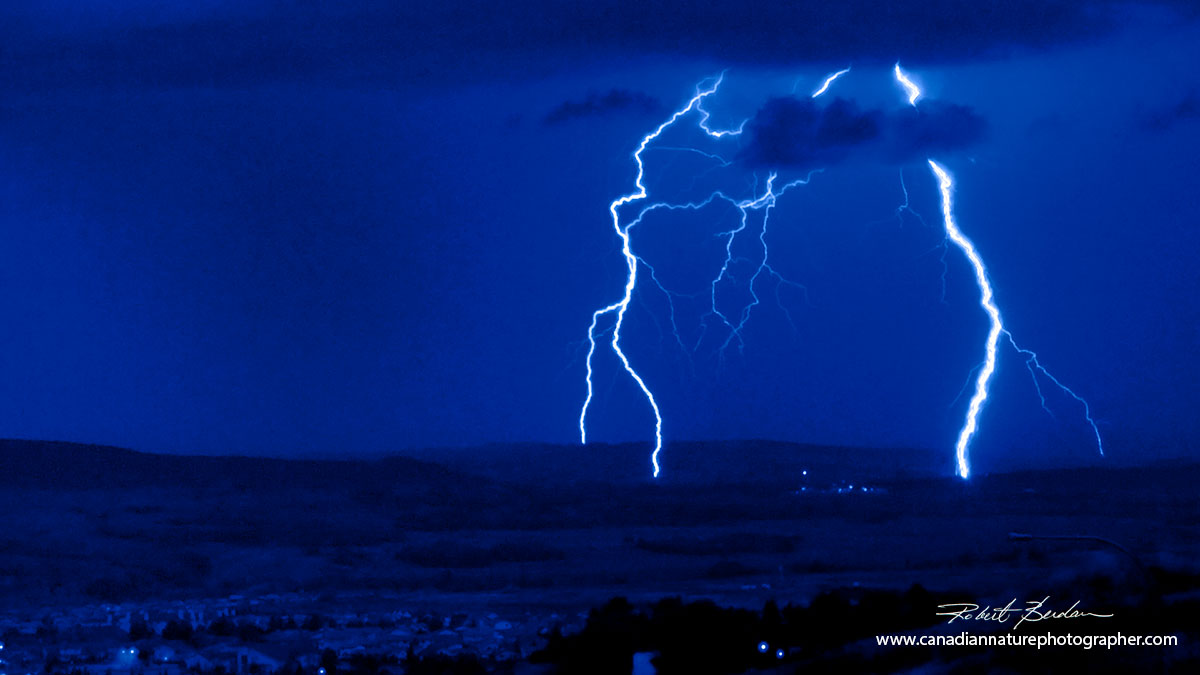
Lightening strike near Cochrane, AB

My father setting up his tripod on a dock before sunrise at Buck Lake, AB
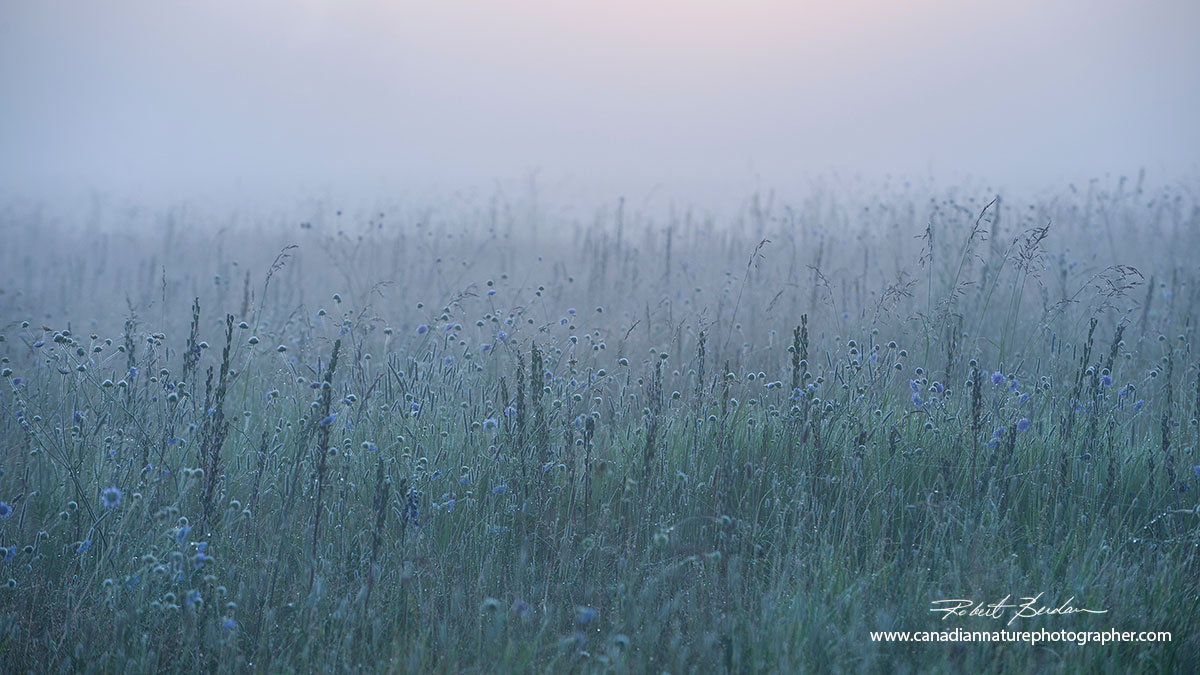
Sibbald creek flats before sunrise in summer. There was a heavy fog in the valley and the flowers were covered with dew.

Light rays piercing through ice fog near Castle Junction, Banff National Park. The temperature was -40°C and I brought a photo group with me. Our digital cameras worked fine and we retreated to our vehicles when we got cold - about every 20 minutes. In this kind of weather it is important to dress appropriately and bring some hand warmers and a hot drink.

Sunrise over the prairies east of Airdrie. I was driving east of Calgary heading to Weed Lake to Photograph shore birds.

Fly fishing is common in southern Alberta, but I never thought folks would fly fish in winter. The fly fisherman in this photo, Frank Wood, asked me to join him and take some photos that were featured in Fly Fishing magazine. The Elk river is a good place to catch bull trout, but you need a license to fish and may need to de-ice your fishing line.

View of the Rocky Mountains from east of Mossleigh and their three grain elevators. I often travel to this area to photograph owls.
Summary
These are just a few of my favourite landscapes from Alberta. I will likely follow this with a second article and more pictures as I have thousands of images I have taken over the years. I enjoy exploring the backroads of Alberta looking for landscapes and wildlife and have many fond memories with friends who joined me. Any place can produce rewarding images if you actively seek them out. If you are coming to Alberta and need a guide I would be happy to take you out - see my workshops page. I offer reasonable rates, provide transportation, instruction and\or photographic advice. While neither I nor anyone else can guarantee wildlife, I can guarantee beautiful landscapes, but not the weather. As I stated above, often bad weather can make for more interesting photos so I go out in any kind of weather as long as it is safe to do so. Exploring by car lets me cover a lot of territory, but other times I prefer the slower pace of hiking and sometimes the smaller and more intimate landscapes including mushrooms, lichen, moss and wildflowers can also be fun. RB
Authors Biography & Contact Information
 Bio: Robert Berdan is a professional nature photographer living in Calgary, AB specializing in nature, wildlife and science photography. Robert retired from Cell\Neurobiology research to take up photography full time years ago. Robert offers photo guiding and private instruction in all aspects of nature photography and Adobe Photoshop training - including photomicrography, macrophotography.
Bio: Robert Berdan is a professional nature photographer living in Calgary, AB specializing in nature, wildlife and science photography. Robert retired from Cell\Neurobiology research to take up photography full time years ago. Robert offers photo guiding and private instruction in all aspects of nature photography and Adobe Photoshop training - including photomicrography, macrophotography.
Email at: rberdan@scienceandart.org
Web site: www.canadiannaturephotographer.com
Phone: MST 9am -7 pm (403) 247-2457.
Click on the buttons below and share this site with your friends